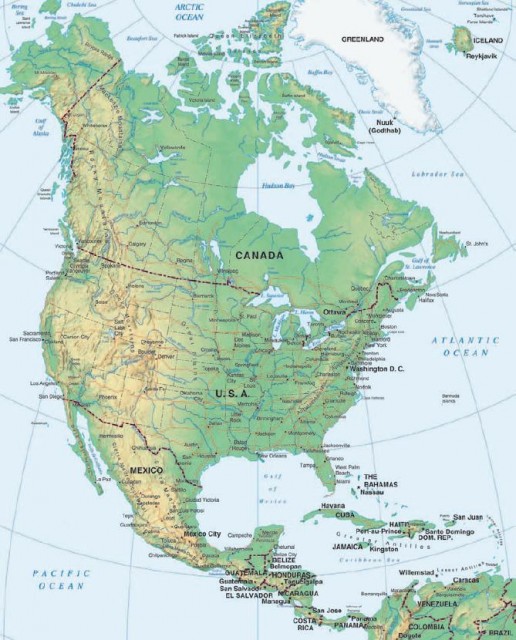Introducing Canada
Imagine you are hiking on a meandering trail through one of Canada's spectacular national parks. As you breathe in deeply, smelling the natural perfume of the evergreens surrounding you in this particular location, you pause to wonder,“Have I experienced Canada before?”
If you have eaten a crisp, juicy McIntosh apple (cultivated in Ontario in 1811 by John McIntosh), you have experienced a taste of Canada! As you zip your backpack, thank Canada for this modern, gripping innovation. Telephones, utilizing technology developed by Canadian resident Alexander Graham Bell in 1876, are an innovation we all have used. The snowmobile, insulin usage for diabetics, and the use of wood pulp for newsprint are other prominent Canadian innovations depended on throughout the world. In fact, 40 percent of the world's newspapers are printed on newsprint manufactured from Canada's lumber industry.
With a land area of 3.8 million square miles (nearly 10 million square kilometers),Canada is the world's second-largest country. It also dominates the northern portion of the North American continent. Three oceans—the Pacific, Arctic, and Atlantic—border Canada's shores. An undefended land border of 5,524 miles, the longest in the world, is shared with the continental United States to the south and with the state of Alaska to the northwest. Because of Canada's tremendous size, the mountains merge with the gently rolling hills of the interior plains and the arctic tundra with ease. Canada's vibrant cities and liberal history for welcoming immigrants make this country a desirable home for some 31 million people. This population, however,when considered with the vast land area, gives Canada one of the world's lowest population densities—about 8 people per square mile.
Marked regional differences are visible in Canada's physical and human landscapes. The diversity of Canada's physical environment ranges from the quiet coves and beaches of the Atlantic Provinces to the fertile grasslands of central Canada's prairies. Numerous lakes dot the rocky cradle of the Canadian Shield, where animals greatly outnumber the people (and mosquitoes outnumber animals!). It is in this core of the North American continent where Hudson's Bay Company thrived as a result of its fur trade. “The Bay,” which once owned over 10 percent of the entire earth's surface, is still in business as the world's oldest company.
Diverse peoples sprinkled throughout the varied landscapes offer seasoning for Canada's colorful heritage and history. Populated historically with aboriginal (native) populations, early cultures were able to take advantage of Canada's blessing of abundant natural elements. Fish, whales, buffalo, and other forms of wildlife were life-sustaining resources. Numerous water routes eased travel and provided access to the interior of the country and additional resources. The richness of the country's resource base also attracted European explorers and settlers who began arriving, with an inquisitive purpose, nearly five centuries ago. This mysterious land offered potential to fulfill a quest for the Northwest Passage, a desired route sought between Europe and the rich markets of the “Orient.” Centuries-long pursuits would bring extended contacts with aboriginal peoples already populating Canada.
Reliance on aboriginal knowledge was beneficial for these explorations.Maps were sketched from memory on birch bark, in the snow, and on the ground by the aboriginal peoples. This wealth of knowledge was often incorporated onto maps drawn by early European explorers.
It was during one of these European meetings with Iroquoian peoples that the name of Canada was first applied. French explorer Jacques Cartier inquired about the land he was exploring in 1535 near present-day Quebec City. The Iroquoian response was “kanata,” the Huron-Iroquois word for “village” or “settlement.”Maps in 1547 thus began showing reference to land north of the St. Lawrence River as “Canada.”
What has molded a unique Canadian identity? From ancient human activity in the Yukon Territory to complexities in government and economy, you will get a glimpse of the defining identities of Canada as you read this book. The faces and places that greet you with impressive diversity offer an invitation to explore.

You are also developing mental maps about the country in which you live. You know the significant holidays celebrated there and the favorite destinations your family likes to visit for fun and relaxation. Learning about Canada by reading books such as this one also helps to create the images you carry in your mind about this country. Asking the questions “Why?” or “Why should we care?” will add more color and impact to the mental maps, impressions, and pictures you are developing. Geographers ask these questions as they study and observe their surroundings. You can, too!
Consider your mental map of Canada. What comes to mind? Perhaps jagged mountain ridges, the hollow song of a loon, prairie grasslands, chocolate-brown moose sloshing through marshy lakes, or creeping ice-blue glaciers. Your mental map of Canada may also include the Toronto Blue Jays, beckoning lighthouses, or sweet drops of golden maple syrup! As you read about Canada, your mental map will be sharpened, and details will become clear. Questions will come to mind. The delight of a journey through such a beautiful country as Canada may lead you to this fascinating land.What is Canada like? Let the experiences of reading and asking geographic questions begin to show you the answers.
- CASE STUDY. Diverse Societies Face Change
- Urban Sprawl
- The Fight Against Terrorism
- Subregions of Canada
- Economy and Culture of Canada
- History and Government of Canada
- The United States and Canada: Human–Environment Interaction
- The United States and Canada: Climate and Vegetation
- The United States and Canada: Landforms and Resources